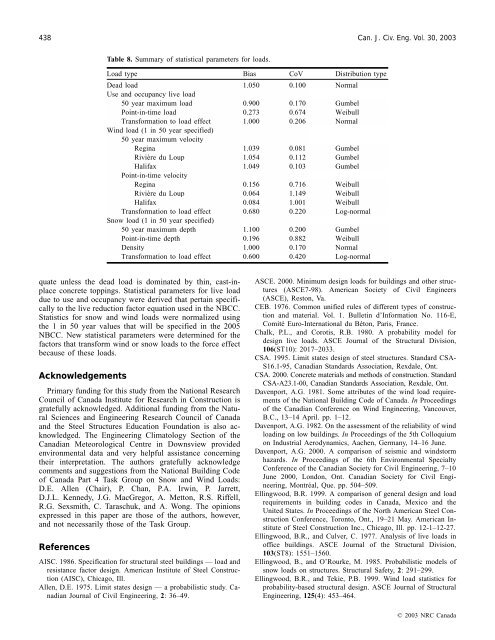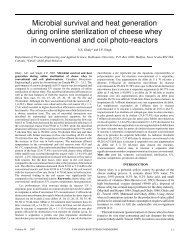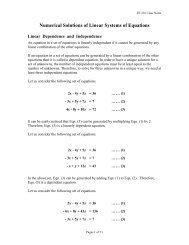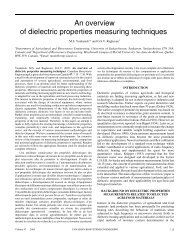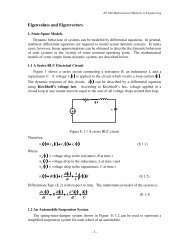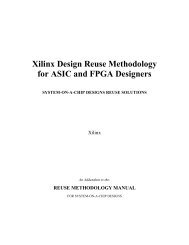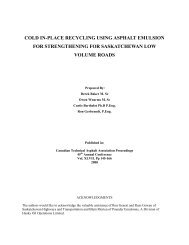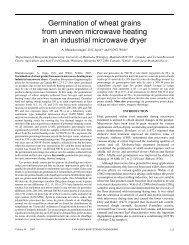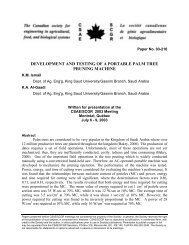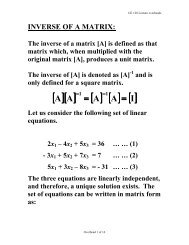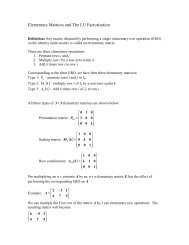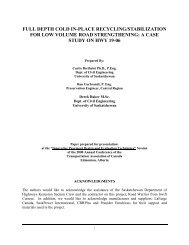438 Can. J. Civ. Eng. Vol. 30, 2003Table 8. Summary <strong>of</strong> statistical parameters <strong>for</strong> loads.<strong>Load</strong> type Bias CoV Distribution typeDead load 1.050 0.100 NormalUse and occupancy live load50 year maximum load 0.900 0.170 GumbelPoint-in-time load 0.273 0.674 WeibullTrans<strong>for</strong>mation to load effect 1.000 0.206 NormalWind load (1 in 50 year specified)50 year maximum velocityRegina 1.039 0.081 GumbelRivière du Loup 1.054 0.112 GumbelHalifax 1.049 0.103 GumbelPoint-in-time velocityRegina 0.156 0.716 WeibullRivière du Loup 0.064 1.149 WeibullHalifax 0.084 1.001 WeibullTrans<strong>for</strong>mation to load effect 0.680 0.220 Log-normalSnow load (1 in 50 year specified)50 year maximum depth 1.100 0.200 GumbelPoint-in-time depth 0.196 0.882 WeibullDensity 1.000 0.170 NormalTrans<strong>for</strong>mation to load effect 0.600 0.420 Log-normalquate unless <strong>the</strong> dead load is dominated by thin, cast-inplaceconcrete toppings. Statistical parameters <strong>for</strong> live loaddue to use and occupancy were derived that pertain specificallyto <strong>the</strong> live reduction <strong>factor</strong> equation used in <strong>the</strong> NBCC.Statistics <strong>for</strong> snow and wind loads were normalized using<strong>the</strong> 1 in 50 year values that will be specified in <strong>the</strong> <strong>2005</strong>NBCC. New statistical parameters were determined <strong>for</strong> <strong>the</strong><strong>factor</strong>s that trans<strong>for</strong>m wind or snow loads to <strong>the</strong> <strong>for</strong>ce effectbecause <strong>of</strong> <strong>the</strong>se loads.AcknowledgementsPrimary funding <strong>for</strong> this study from <strong>the</strong> <strong>National</strong> ResearchCouncil <strong>of</strong> Canada Institute <strong>for</strong> Research in Construction isgratefully acknowledged. Additional funding from <strong>the</strong> NaturalSciences and Engineering Research Council <strong>of</strong> Canadaand <strong>the</strong> Steel Structures Education Foundation is also acknowledged.The Engineering Climatology Section <strong>of</strong> <strong>the</strong>Canadian Meteorological Centre in Downsview providedenvironmental data and very helpful assistance concerning<strong>the</strong>ir interpretation. The authors gratefully acknowledgecomments and suggestions from <strong>the</strong> <strong>National</strong> Building Code<strong>of</strong> Canada Part 4 Task Group on Snow and Wind <strong>Load</strong>s:D.E. Allen (Chair), P. Chan, P.A. Irwin, P. Jarrett,D.J.L. Kennedy, J.G. MacGregor, A. Metton, R.S. Riffell,R.G. Sexsmith, C. Taraschuk, and A. Wong. The opinionsexpressed in this paper are those <strong>of</strong> <strong>the</strong> authors, however,and not necessarily those <strong>of</strong> <strong>the</strong> Task Group.ReferencesAISC. 1986. Specification <strong>for</strong> structural steel buildings — load andresistance <strong>factor</strong> design. American Institute <strong>of</strong> Steel Construction(AISC), Chicago, Ill.Allen, D.E. 1975. Limit states design — a probabilistic study. CanadianJournal <strong>of</strong> Civil Engineering, 2: 36–49.ASCE. 2000. Minimum design loads <strong>for</strong> buildings and o<strong>the</strong>r structures(ASCE7-98). American Society <strong>of</strong> Civil Engineers(ASCE), Reston, Va.CEB. 1976. Common unified rules <strong>of</strong> different types <strong>of</strong> constructionand material. Vol. 1. Bulletin d’In<strong>for</strong>mation No. 116-E,Comité Euro-International du Béton, Paris, France.Chalk, P.L., and Corotis, R.B. 1980. A probability model <strong>for</strong>design live loads. ASCE Journal <strong>of</strong> <strong>the</strong> Structural Division,106(ST10): 2017–2033.CSA. 1995. Limit states design <strong>of</strong> steel structures. Standard CSA-S16.1-95, Canadian Standards Association, Rexdale, Ont.CSA. 2000. Concrete materials and methods <strong>of</strong> construction. StandardCSA-A23.1-00, Canadian Standards Association, Rexdale, Ont.Davenport, A.G. 1981. Some attributes <strong>of</strong> <strong>the</strong> wind load requirements<strong>of</strong> <strong>the</strong> <strong>National</strong> Building Code <strong>of</strong> Canada. In Proceedings<strong>of</strong> <strong>the</strong> Canadian Conference on Wind Engineering, Vancouver,B.C., 13–14 April. pp. 1–12.Davenport, A.G. 1982. On <strong>the</strong> assessment <strong>of</strong> <strong>the</strong> reliability <strong>of</strong> windloading on low buildings. In Proceedings <strong>of</strong> <strong>the</strong> 5th Colloquiumon Industrial Aerodynamics, Aachen, Germany, 14–16 June.Davenport, A.G. 2000. A comparison <strong>of</strong> seismic and windstormhazards. In Proceedings <strong>of</strong> <strong>the</strong> 6th Environmental SpecialtyConference <strong>of</strong> <strong>the</strong> Canadian Society <strong>for</strong> Civil Engineering, 7–10June 2000, London, Ont. Canadian Society <strong>for</strong> Civil Engineering,Montréal, Que. pp. 504–509.Ellingwood, B.R. 1999. A comparison <strong>of</strong> general design and loadrequirements in building codes in Canada, Mexico and <strong>the</strong>United States. In Proceedings <strong>of</strong> <strong>the</strong> North American Steel ConstructionConference, Toronto, Ont., 19–21 May. American Institute<strong>of</strong> Steel Construction Inc., Chicago, Ill. pp. 12-1–12-27.Ellingwood, B.R., and Culver, C. 1977. Analysis <strong>of</strong> live loads in<strong>of</strong>fice buildings. ASCE Journal <strong>of</strong> <strong>the</strong> Structural Division,103(ST8): 1551–1560.Ellingwood, B., and O’Rourke, M. 1985. Probabilistic models <strong>of</strong>snow loads on structures. Structural Safety, 2: 291–299.Ellingwood, B.R., and Tekie, P.B. 1999. Wind load statistics <strong>for</strong>probability-based structural design. ASCE Journal <strong>of</strong> StructuralEngineering, 125(4): 453–464.© 2003 NRC Canada
Bartlett et al. 439Ellingwood, B.R., Galambos, T.V., MacGregor, J.G., andCornell, C.A. 1980. Development <strong>of</strong> a probability based loadcriterion <strong>for</strong> American <strong>National</strong> Standard A58. NBS SpecialPublication 577, <strong>National</strong> Bureau <strong>of</strong> Standards, U.S. Department<strong>of</strong> Commerce, Washington, D.C.European Committee <strong>for</strong> Standardization. 1994. ENV 1991-1:1994 Eurocode 1: basis <strong>of</strong> design and actions on structures —Part 1: basis <strong>of</strong> design. European Committee <strong>for</strong> Standardization,Brussels, Belgium.Kariyawasam, S.N. 1996. Development <strong>of</strong> probability based resistance<strong>factor</strong>s and companion-action load <strong>factor</strong>s <strong>for</strong> concrete designin Canada. Ph.D. <strong>the</strong>sis, University <strong>of</strong> Alberta, Edmonton,Alta.Kariyawasam, S.N., Rogowsky, D.M., and MacGregor, J.G. 1997.Resistance <strong>factor</strong>s and companion-action load <strong>factor</strong>s <strong>for</strong> rein<strong>for</strong>cedconcrete building design in Canada. Canadian Journal <strong>of</strong>Civil Engineering, 24: 593–602.Kemp, A.R., Mahachi, J., and Mil<strong>for</strong>d, R. 1998. Developing LRFDcodes in South Africa. In Proceedings <strong>of</strong> <strong>the</strong> Structural EngineersWorld Congress, San Francisco, Calif. 19–23 July. ReferenceP315-3.MacGregor, J.G. 1976. Safety and limit states design <strong>for</strong> rein<strong>for</strong>cedconcrete. Canadian Journal <strong>of</strong> Civil Engineering, 3: 484–513.MacGregor, J.G., Kennedy, D.J.L., Bartlett, F.M., Chernenko, D.,Maes, M.A., and Dunaszegi, L. 1997. Design criteria and loadand resistance <strong>factor</strong>s <strong>for</strong> <strong>the</strong> Confederation Bridge. CanadianJournal <strong>of</strong> Civil Engineering, 24: 882–897.NBCC. 1995. <strong>National</strong> Building Code <strong>of</strong> Canada. Institute <strong>for</strong> Researchin Construction, <strong>National</strong> Research Council <strong>of</strong> Canada,Ottawa, Ont.Newark, M.J. 1984. A new look at ground snow loads in Canada.In Proceedings <strong>of</strong> <strong>the</strong> Eastern Snow Conference, 41st AnnualMeeting, Washington, D.C. Vol. 29, pp. 37–48.Newmark, M.J., Welsh, L.E., Morris, R.J., and Dnes, W.V. 1989.Revised ground snow loads <strong>for</strong> <strong>the</strong> 1990 <strong>National</strong> Building Code<strong>of</strong> Canada. Canadian Journal <strong>of</strong> Civil Engineering, 16: 267–278.Nowak, A.S., and Lind, N.C. 1979. Practical code <strong>calibration</strong> procedures.Canadian Journal <strong>of</strong> Civil Engineering, 6: 112–119.O’Rourke, M.J., Redfield, R., and Von Bradsky, P. 1982. Uni<strong>for</strong>msnow loads on structures. ASCE Journal <strong>of</strong> <strong>the</strong> Structural Division,108(ST12): 2781–2798.Peir, J.C., and Cornell, C.A. 1973. Spatial and temporal variability<strong>of</strong> live loads. ASCE Journal <strong>of</strong> <strong>the</strong> Structural Division, 99(ST5):903–922.Rosowsky, D.V., and Cheng, N. 1999. Reliability <strong>of</strong> light-framero<strong>of</strong>s in high-wind regions. ASCE Journal <strong>of</strong> Structural Engineering,125(7): 725–733.South Africa Bureau <strong>of</strong> Standards. 1989. The general proceduresand loadings to be adopted in <strong>the</strong> design <strong>of</strong> buildings: SABS0160:1989. South Africa Bureau <strong>of</strong> Standards, Pretoria, SouthAfrica.Standards Association <strong>of</strong> Australia. 1985. Guidelines <strong>for</strong> conversionto limit states codes, Committee BD16 — <strong>Load</strong>ing <strong>of</strong>Structures. Standards Association <strong>of</strong> Australia, Canberra, Australia.Tabsh, S.W. 1997. Safety <strong>of</strong> rein<strong>for</strong>ced concrete members designedfollowing ACI 318 building code. Engineering Structures,19(10): 843–850.Taylor, D.A., and Allen, D.E. 2000. Statistical variation and duration<strong>of</strong> snow load on flat ro<strong>of</strong>s in Canada. Institute <strong>for</strong> Researchin Construction, <strong>National</strong> Research Council <strong>of</strong> Canada, Ottawa,Ont. Unpublished study.Turkstra, C.J. 1972. Theory <strong>of</strong> structural design decisions. SolidMechanics Study 2, University <strong>of</strong> Waterloo, Waterloo, Ont.Wen, Y.K. 1990. Structural load modelling and combination <strong>for</strong>per<strong>for</strong>mance and safety evaluation. Elsevier, Amsterdam, TheNe<strong>the</strong>rlands.List <strong>of</strong> symbolsA I influence areaB tributary areaC a snow accumulation <strong>factor</strong>C b basic ro<strong>of</strong> snow load <strong>factor</strong>C e exposure <strong>factor</strong> <strong>for</strong> wind loadC g gust <strong>factor</strong> <strong>for</strong> wind loadC gr ground-to-ro<strong>of</strong> snow load trans<strong>for</strong>mation <strong>factor</strong>C p external pressure coefficient <strong>for</strong> wind loadC s slope <strong>factor</strong> <strong>for</strong> snow loadC w wind exposure <strong>factor</strong> <strong>for</strong> snow loadCoV coefficient <strong>of</strong> variationCoV a coefficient <strong>of</strong> variation <strong>of</strong> annual maximum loadd snow depthE wind exposure <strong>factor</strong>L live load due to use and occupancyI max mean 50 year maximum live load due to use and occupancyn number <strong>of</strong> ro<strong>of</strong>s in <strong>the</strong> samplep wind pressureP effect due to permanent loadq reference velocity pressureq T reference wind pressure with T year return periodS snow loadS i principal transient loadS j companion-action transient loadS r rain load associated with ground snow loadS s ground snow loadT return period or <strong>the</strong>rmal characteristic <strong>factor</strong>V T wind velocity with 50 year return periodV max mean 50 year maximum wind velocityV 50 with 50 year return period wind velocityα load <strong>factor</strong>α i load <strong>factor</strong> applied to <strong>the</strong> effects due to <strong>the</strong> principaltransient loadα ij load <strong>factor</strong> applied to <strong>the</strong> companion-action transientloadsα P load <strong>factor</strong> applied to <strong>the</strong> effects due to permanent loadsuch as dead loadγ unit weight <strong>of</strong> snow∆ maximum excess thickness <strong>of</strong> cast-in-place toppingε error term in ground to ro<strong>of</strong> snow load trans<strong>for</strong>mation<strong>factor</strong>ρ density2σ Lmax variance <strong>of</strong> 50 year maximum live load due to use andoccupancy© 2003 NRC Canada


